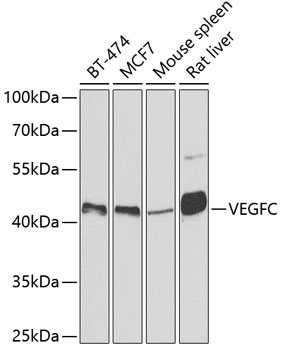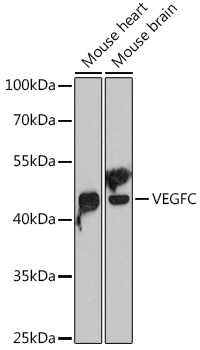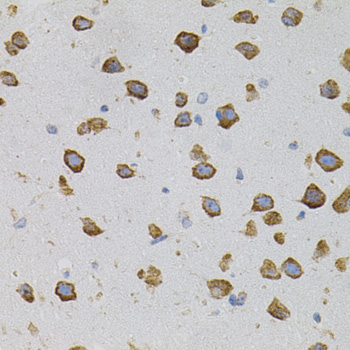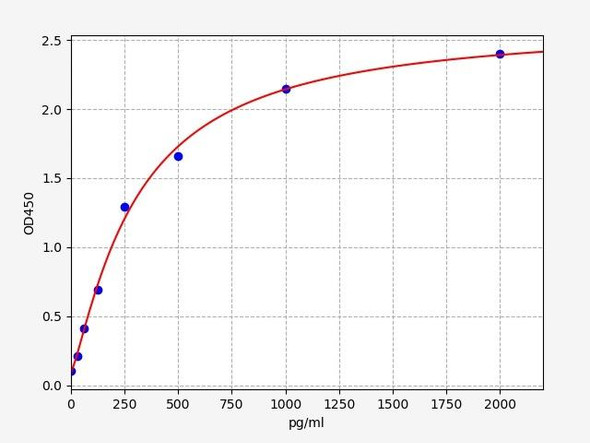Anti-VEGFC Antibody (CAB2556)
- SKU:
- CAB2556
- Product type:
- Antibody
- Reactivity:
- Human
- Mouse
- Rat
- Host Species:
- Rabbit
- Isotype:
- IgG
- Research Area:
- Cardiovascular
Description
Anti-VEGFC Antibody
VEGFC protein is encoded by the VEGFC gene and plays an important role in cancer progression. VEGFC has been shown to be overexpressed in several cancer types, including breast, pancreatic, lung and colon cancers. It can also be found over expressed in cardiovascular disease and diabetic complications as well. The Anti-VEGFC antibody from Assay Genie can be used in Western Blot and Immunohistochemistry applications.
| Antibody Name: | Anti-VEGFC Antibody |
| Antibody SKU: | CAB2556 |
| Antibody Size: | 20uL, 50uL, 100uL |
| Application: | WB IHC |
| Reactivity: | Human, Mouse, Rat |
| Host Species: | Rabbit |
| Immunogen: | A synthetic peptide of human VEGFC |
| Application: | WB IHC |
| Recommended Dilution: | WB 1:500 - 1:2000 IHC 1:100 - 1:200 |
| Reactivity: | Human, Mouse, Rat |
| Positive Samples: | BT-474, MCF7, Mouse spleen, Rat liver, Mouse heart, Mouse brain |
| Immunogen: | A synthetic peptide of human VEGFC |
| Purification Method: | Affinity purification |
| Storage Buffer: | Store at -20°C. Avoid freeze / thaw cycles. Buffer: PBS with 0.02% sodium azide, 50% glycerol, pH7.3. |
| Isotype: | IgG |
| Sequence: | Email for sequence |
| Gene ID: | 7424 |
| Uniprot: | P49767 |
| Cellular Location: | Secreted |
| Calculated MW: | 46kDa |
| Observed MW: | 47kDa |
| Synonyms: | VEGFC, Flt4-L, LMPH1D, VRP |
| Background: | The protein encoded by this gene is a member of the platelet-derived growth factor/vascular endothelial growth factor (PDGF/VEGF) family. The encoded protein promotes angiogenesis and endothelial cell growth, and can also affect the permeability of blood vessels. The proprotein is further cleaved into a fully processed form that can bind and activate VEGFR-2 and VEGFR-3 receptors. |
| UniProt Protein Function: | VEGFC: Growth factor active in angiogenesis, and endothelial cell growth, stimulating their proliferation and migration and also has effects on the permeability of blood vessels. May function in angiogenesis of the venous and lymphatic vascular systems during embryogenesis, and also in the maintenance of differentiated lymphatic endothelium in adults. Binds and activates VEGFR-2 (KDR/FLK1) and VEGFR-3 (FLT4) receptors. Homodimer; non-covalent and antiparallel. Spleen, lymph node, thymus, appendix, bone marrow, heart, placenta, ovary, skeletal muscle, prostate, testis, colon and small intestine and fetal liver, lung and kidney, but not in peripheral blood lymphocyte. Belongs to the PDGF/VEGF growth factor family. |
| UniProt Protein Details: | Protein type:Cell cycle regulation; Motility/polarity/chemotaxis; Secreted, signal peptide; Secreted; Cytokine Chromosomal Location of Human Ortholog: 4q34.3 Cellular Component: extracellular space; membrane; extracellular region Molecular Function:protein binding; growth factor activity; vascular endothelial growth factor receptor 3 binding; chemoattractant activity Biological Process: signal transduction; induction of positive chemotaxis; negative regulation of cell proliferation; morphogenesis of embryonic epithelium; platelet degranulation; positive chemotaxis; regulation of vascular endothelial growth factor receptor signaling pathway; positive regulation of cell proliferation; negative regulation of blood pressure; angiogenesis; positive regulation of cell-matrix adhesion; response to drug; substrate-bound cell migration; positive regulation of neuroblast proliferation; platelet activation; positive regulation of blood vessel endothelial cell migration; positive regulation of protein amino acid autophosphorylation; positive regulation of peptidyl-tyrosine phosphorylation; organ morphogenesis; positive regulation of angiogenesis; positive regulation of protein secretion; positive regulation of cell division; blood coagulation; vascular endothelial growth factor receptor signaling pathway; positive regulation of epithelial cell proliferation Disease: Lymphedema, Hereditary, Id |
| NCBI Summary: | The protein encoded by this gene is a member of the platelet-derived growth factor/vascular endothelial growth factor (PDGF/VEGF) family. The encoded protein promotes angiogenesis and endothelial cell growth, and can also affect the permeability of blood vessels. The proprotein is further cleaved into a fully processed form that can bind and activate VEGFR-2 and VEGFR-3 receptors. [provided by RefSeq, Apr 2014] |
| UniProt Code: | P49767 |
| NCBI GenInfo Identifier: | 1718154 |
| NCBI Gene ID: | 7424 |
| NCBI Accession: | P49767.1 |
| UniProt Secondary Accession: | P49767,B2R9Q8, |
| UniProt Related Accession: | P49767 |
| Molecular Weight: | 46,883 Da |
| NCBI Full Name: | Vascular endothelial growth factor C |
| NCBI Synonym Full Names: | vascular endothelial growth factor C |
| NCBI Official Symbol: | VEGFC |
| NCBI Official Synonym Symbols: | VRP; Flt4-L; LMPH1D |
| NCBI Protein Information: | vascular endothelial growth factor C; FLT4 ligand DHM; vascular endothelial growth factor-related protein |
| UniProt Protein Name: | Vascular endothelial growth factor C |
| UniProt Synonym Protein Names: | Flt4 ligand; Flt4-L; Vascular endothelial growth factor-related protein; VRP |
| Protein Family: | Vascular endothelial growth factor |
| UniProt Gene Name: | VEGFC |
| UniProt Entry Name: | VEGFC_HUMAN |












